|
The London Charterhouse was founded at Smithfield, a little to the north-west of the city wall, by Sir Walter Manny and
Bishop Michael Northburgh of London in 1371. It was set up near a 1348 plague pit where many victims of the Black Death were
buried. The twenty-five monks each had their own small building and garden. Thomas More came to the monastery for spiritual
recuperation.
The London Charterhouse was constructed over many years. The great cloister wad constructed cell by cell as funds became
available. Original built as a double house. The cells were built in a clokcwise direction between 1371 and 1436.
The chapel, originally built for the graveyard by Manny, was used as the conventual church. The original building was
a simple rectangle of 94 by 38 feet, divided internally into presbytery, choir, and a small body of the church at the
western end, divided from the choir by a wooden screen with two altars against its western face. The area fo the body of the
church which was seperated from the choir was a place for the public. In 1405 an extension of 30' in length was
added to the west to accomadate the growing number of public tha twish to attend Mass. This ante-chapel was seperated from
the original church by a second screen and was called the chapel of Saint Anne. Additional chapels and tombs continued to
be built.
The reputation of the Charterhouse had stood very high for at least fifty years. At the end of the previous century the
young Thomas More had spent four years as an inmate of the house in his early days at the law, attending the offices and following
much of the monastic routine before deciding that his call lay elsewhere. Twenty years later Chauncy, also a law student,
was familiar with the remark that those who wished to hear the divine service worthily performed should go to the Charterhouse. In
Houghton's day we are told that Sir John Gage, vice-chamberlain of the court, thought of becoming a monk there when he could
no longer serve the king. Not only the quality, but the number also of recruits was remarkable, and it is probable that here,
as at contemporary Mount Grace, there was a 'waiting-list' of postulants, and that it was this that made necessary the
addition of a group of 'little' cells at one corner of the cloister.
In June 1534, at least nine in the community refused to take the oath of acceptance of the royal supremacy. Prior Houghton
knew that in time the oath would be demanded. So he urged his monks to spend their time in prayer and preparation
for trial he was sure would come. On November 1534 the Act of Supremacy was passed that would charge anyone who denied
the king was supreme head on earth of the Church of England with high treason. While awaiting the summons, Houghton was visited
by the Priors of Beauvale and Axholme. The former, Robert Laurence, was a professed monk of London who had succeeded Houghton
on the latter's recall. After a series of interviews and examinations before Cromwell, the three priors were lodged in
the Tower; they were tried on 28-29 April and condemned to death for refusal to accept the royal supremacy. They were
executed at Tyburn on 4 May.
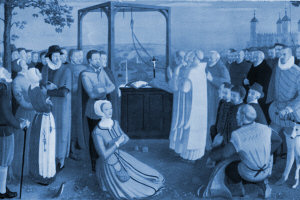
Next to be taken to Newgate for failing to take the oath were William Exmew, the Procurator, and Sebastian Newdigate,
vicar. They spent a fortnight chained by neck and legs to post. Then on 11 June they were tried and sondemed. On 19 June they
were executed. Those who remained at the Charterhouse were persecuted and were continual guarded by Cromwell's men. By May
1536 four more were exiled; and numerous transferred to other cities and some new monks imported through 1538. Ten more monks
stilll refused to swear; three priests, a deacon, and six lay brothers. On 18 May these were lodged in Newgate and chained
to posts, where all save one died of starvation or disease during the summer. The one survivor, William Horne, was kept a
prisoner and executed at Tyburn on 4 August 1540. These monks constitute the group known as Carthusian Martyrs.
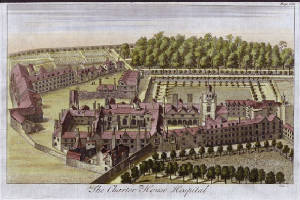
|
| The Charterhouse in 1770. |
The Charterhouse was abondoned by 1542 and sold in 1546 to Lord North who used it as a home. It eventually came into
the hands of Thomas Sutton. Upon his death on the 12 December 1611, he endowed a hospital on the site of the Charterhouse.
And in his will he bequeathed moneys to maintain a chapel, hospital and a school.
The school, Charterhouse School, developed beyond the original intentions of its founder, and now ranks among the most
eminent public schools in England. In 1872 it was removed, during the headmastership of the Rev. William Haig-Brown, to new
buildings near Godalming in Surrey, which were opened on the 18 June in that year. Since then, the students in their first
year visit the Old Charterhouse as part of their introduction to the school.
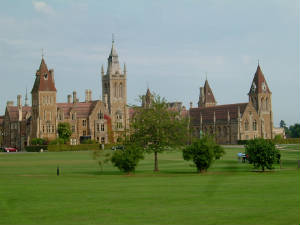
|
| Charterhouse School in Surrey |
Hidden Life of Charterhouse
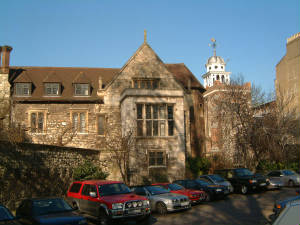
|
| The London Charterhouse |
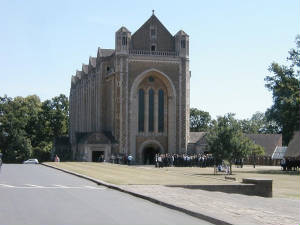
|
| Charterhouse Chapel |
Priors of the London Charterhouse [1]
John Luscote, occurs 1370; died 1398
John Okendon, occurs 1398; resigned 1412
John Maplested, occurs
1412-c. 1440
John Thorne, occurs c. 1440; resigned c. 1448
John Walweyn, occurs c. 1448; died 1449
John
Seman, occurs 1449-c. 1468
Edmund or Edward Storer, occurs 1469; resigned 1477
John Walsingham, occurs
1477-c. 1488
Richard Roche, occurs c. 1488; resigned 1500
William Tynbygh (Tynbegh), occurs 1500; resigned
1529
John Batmanson, occurs 1529; died 1531
John Houghton, occurs 1531; executed 1535
William Trafford, occurs
1536-8
For a more extensive history read 'Religious Houses: House of Carthusian monks', A History of the County of Middlesex: Volume 1: Physique, Archaeology, Domesday, Ecclesiastical Organization, The Jews,
Religious Houses, Education of Working Classes to 1870, Private Education from Sixteenth Century (1969), pp. 159-69.
[1] From the above referenced link.
Charterhouses
Martyrs of England
Top of Page
|
